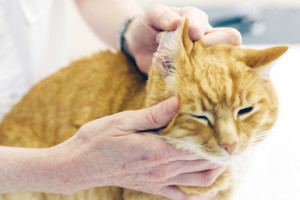What Do You Do If Your Pet Has An Ear Infection?
 With the summer sun beating down on us and we try to break the doldrums of summer, many people are trying to keep their pets cool by allowing them to swim. Did you know that more than 20% of dogs have some form of ear infections? In the hot, humid areas, it can range up in the 50% range. Imagine that, 1 out of every 2 dogs having to deal with an ear infection. Otitis is considered a type of skin disease that is very common in pets and causes a lot of distress to owners and discomfort and pain to the pet.
With the summer sun beating down on us and we try to break the doldrums of summer, many people are trying to keep their pets cool by allowing them to swim. Did you know that more than 20% of dogs have some form of ear infections? In the hot, humid areas, it can range up in the 50% range. Imagine that, 1 out of every 2 dogs having to deal with an ear infection. Otitis is considered a type of skin disease that is very common in pets and causes a lot of distress to owners and discomfort and pain to the pet.
Full blown ear infections are easy to detect. There may be clinical signs that include odor, scratching or rubbing of the ears and head, discharge in the ears, redness or swelling of the ear flap or canal, shaking of the head or tilting to one side, pain around ears, or changes in your pets’ behavior.
Ear infections usually arise from primary and secondary factors that create a perfect storm for these infections. The primary factors are those that touch of the inflammatory process that create moisture, heat and stagnate air flow which allows the secondary factors such as yeast, bacteria, swelling and debris to take hold. The secondary factors are the ones that cause still more moisture, heat and stagnant air to build up causing a viscous cycle of misery for you pet.
The primary factors that cause ear infections include:
- Anatomy – The ear canal of a dog is L-shaped and many dogs have large pendulous ears. This traps warm air, debris and moisture, creating a perfect environment for the germs to grow. Also the Cocker Spaniel breed has more apocrine glands in the ear canal which produces more ear wax which compounds the problem.
- Environment – Frequent swimming, exposure to plants and pollens, time spent in wooded areas where plant awns or burrs can get lodged in the ear, or simply the humid heat of summer can set the stage for ear trouble.
- Allergies – Itchy, infected ears can be a classic sign of allergic skin disease in dogs. In fact otitis may be the first and only sign. What starts out as a simple ear infection often becomes a chronic problem until the underlying allergy is addressed.
- Parasites – Ear mites are more common in cats than dogs. Ear mites cause inflammation, discharge and an intense itch that can lead to self trauma and secondary infection. These can be easily treated with diagnosis and proper veterinary care.
- Foreign bodies – With pets that tend to like to run through tall grasses, plant awns can get lodged in the ear and cause intense itching, scratching, and secondary infection. These can be easily seen with the use of an otoscope on examination.
- Tumors – Infected tumors inside the ear trap moisture and debris and are the perfect place for germs to grow. These tend to be seen more in cats.
- Other medical conditions – Hypothyroidism and generalized skin disorders including seborrhea, can spark inflammation that leads to otitis externa.
The ear infections are not easy to miss, but the treatment only works when we address both the primary and the secondary causes. So a thorough examination is important to determine this. After looking at this, the veterinarian will then hone in on the ears. This will include looking at the ear canal and the ear drum with an instrument called an otoscope. Samples of the discharge may be taken to identify the yeast or bacteria by a microscopic examination or culture.
The first step in treating otitis externa is a thorough cleaning of the infected ears. A deep cleaning rids the ear of the secondary factors such as bacteria, yeast and debris. Sometimes the ears may be so painful, anti-inflammatories may be given to reduce the redness and pain first. In severe cases, your veterinarian may recommend that an ear flush be conducted under sedation so that special probes and deep flushing equipment can be used.
Once the ear is clean and dry, topical medications are prescribed to keep the yeast and bacteria under control. Your vet will prescribe medications that contain a combination of antibacterial, anti-fungal, and anti-itch medications. In severe cases, oral antibiotics or other medications may be used.
For treatment to be successful, the underlying cause must be addressed. This may include treating for ear mites, reducing swimming among other things. Your veterinarian may do further blood work or other diagnostics to probe for underlying health issues like allergies and hypothyroidism.
It is important to give immediate attention to the ear infections because numerous complications can arise which may be irreversible. These include chronic changes to the ear canals, ear hematomas, or middle and inner ear infections. Because of this please consult your veterinarian anytime you observe your pet performing frequent head-shaking, pain, redness or discharge from your pets’ ear. And of course, contact our office if you have any questions.

